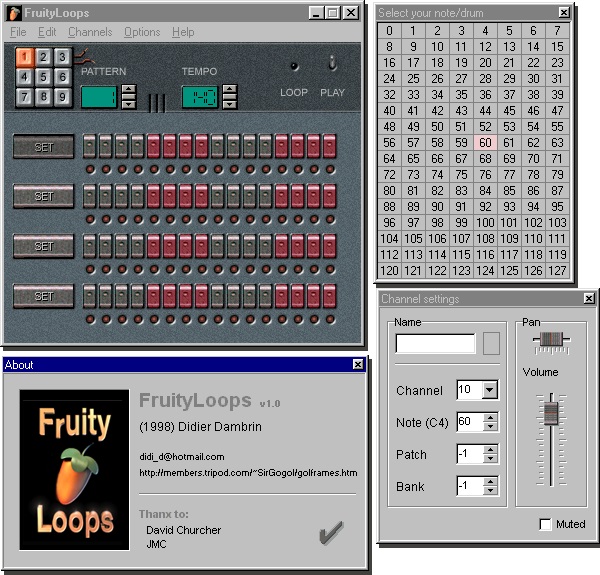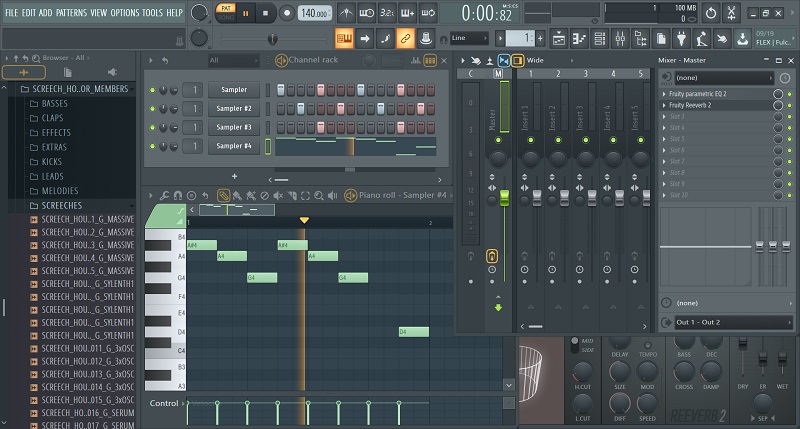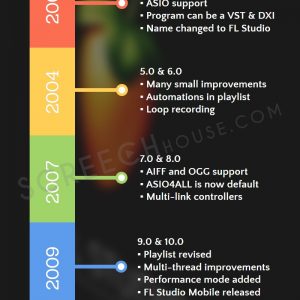In this special post, you will witness the evolution of FL Studio from Fruity Loops 1.0 to FL Studio 20. Throughout history, FL Studio has changed from an unofficial hobby project to an all-round Digital Audio Workstation (D.A.W.), which just means an application dedicated to music production.
If you’re an FL Studio beginner and you want to make music as fast as possible, start now with the FL Studio Beginner’s Guide by clicking this link.
Evolution of Fruity Loops 1.0 to 3
The transformation of FL Studio started back in 1997-1998 where the first version was unofficially released under the name “Fruity Loops 1.0” Created by developer Didier Dambrin, Fruity Loops was basically only a MIDI drum machine, yet it already had the familiar fruity logo. Moreover, it even came with the well-known Step Sequencer (later called the Channel Rack) and Pattern Selector which we take for granted today. While still being in its infancy, it set the stage for becoming a revolutionary piece of software loved by millions of people worldwide.

Soon after, in 1999 Fruity Loops evolved into version 2.0. But it was in 2001 with the release of Fruity Loops 3 where it took a giant leap forward in functionality and design. In Fruity Loops 3, many options where included, such as the Playlist and Browser. This, among other things, changed the overall workflow. However, for many years to come, FL Studio’s design almost remained unchanged, except for some slight modifications and consistent additional features over time.
But there was one exception. In 2003, with the release of version 4, Fruity Loops changed its name to FL Studio. Thereby, FL Studio became a more mature brand. The name-change was necessary to avoid trademark issues, creating a better marketing appeal and being taken more seriously. After all, it’s now a full functioning application reaching many music producers across the globe.
Evolution of FL Studio 4 to FL Studio 12
During the 2000’s, FL Studio mainly transformed in functionality and bug-fixes, such as added new instruments, effects or workflow changes of the Playlist and Channel Rack. Of course, there were also small design changes, but nothing really major. So, from version 4 all the way to FL Studio 11, a lot has been improved, but not specifically in a visual manner. Inevitably, this had to change…
In 2015, FL Studio 12 saw the light. And with that, a brand new design. Instead of the recognizable light-grey menus, they were now dark-grey with a more solid look. Also, FL Studio got a more responsive design which had a more modern feel to it. Overall, the experience was way smoother and all elements were nicely integrated. Such a big change was necessary to fit into the technological demands of the late 2010’s and even early 2020’s.
Last but not least, in 2018 FL Studio 12 evolved into FL Studio 20. This new edition was another improvement from its precursor. Although there were no major graphical modification, something else stood out: its name. FL Studio 20? Shouldn’t it be FL Studio 13? It seemed like they skipped a few generations.

FL Studio 12 changed to FL Studio 20
Now, you may think this has to do with 13 being the unlucky number. Nonetheless, this is not the case. The name was actually introduced as a celebration of the 20-year old anniversary of FL Studio. You see, 1998 was the year of the first (unofficial) release of Fruity Loops 1.0. Thus, 2018 was its 20-year existence and so, being included as the version number.
Of course, the evolution of FL Studio doesn’t stop here. Until this day, FL Studio is still immensely popular and doesn’t seem to go anywhere anytime soon. Therefore, expect many more editions to come, hopefully with many useful features and positive changes. As I see it, FL Studio has been improving consistently by stepping in the shoes of the user, which ultimately resulted in the best version to date. So, if the creators keep doing that, the next version will be even more spectacular.
Create your own FL Studio history
Now, if you are also an FL Studio user or you’re thinking about starting, I highly recommend following the FL Studio Beginner’s Guide. The FL Studio Beginner’s Guide is a unique guide that will show you how to make music quickly by only using the essential basics. Therefore, it’s an ultimate shortcut for anyone who’s relatively new to FL Studio.
That’s why; if you also want to kick-start your producer’s success and make songs as fast as possible, start right now with the FL Studio Beginner’s Guide by clicking this link.
Act now, as it may only be temporarily available.
I’ll see you there.
– Cep
(Music producer, author & creator of Screech House)

